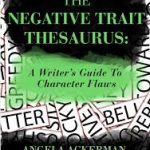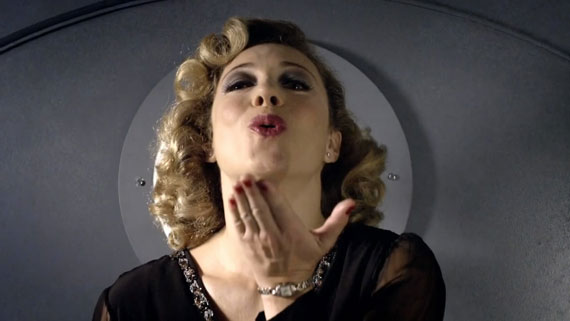Getting to the Core of Character Motivation
Today’s guest post is the first of two from author Becca Puglisi. With her blogging partner, Angela Ackerman, she has written three essential resource books for fiction writers that I can’t recommend enough. Last year they released The Emotion Thesaurus to great acclaim, and now they have followed through with the release of the companion books The Positive Trait Thesaurus and The Negative Trait Thesaurus. Because I feel the information they expound on in these books is so important for novelists to understand and master, I asked Becca to share some of the material from these two new releases with the readers of Live Write Thrive. If you want to be a great novelist, you need these books and should use them extensively as a resource in your writing.
What is it about excellent books that stick with us? Sometimes it’s a heart-wrenching scenario, like the one I recently read in Between Shades of Grey by Ruta Sepetys. It might be a really cool setting or concept like we found within Hogwarts. Honestly, that elusive quality that makes a book unforgettable is hard to define and could be any of a number of things.
But the one common thread in all of the books that are falling apart on my shelf? Characters—flawed ones with desires and needs who spend most of the story tripping over their weaknesses in an effort to get what they want.
 Unfortunately, when it comes to writing this kind of character in a smooth, engaging way, the task can be a little daunting. This is one of the reasons Angela and I wrote The Negative Trait Thesaurus: A Writer’s Guide to Character Flaws—to explain what the character arc is and break it into manageable pieces for writers. Below is the excerpt from our book that deals with this important concept. Hopefully, it will turn on a light bulb or two for you.
Unfortunately, when it comes to writing this kind of character in a smooth, engaging way, the task can be a little daunting. This is one of the reasons Angela and I wrote The Negative Trait Thesaurus: A Writer’s Guide to Character Flaws—to explain what the character arc is and break it into manageable pieces for writers. Below is the excerpt from our book that deals with this important concept. Hopefully, it will turn on a light bulb or two for you.
CHARACTER ARC 101
The internal change that a character undergoes over the course of a story is called the character arc. At the beginning, he views himself and the world one way, but through growth and inner transformation, he comes to view his life on a deeper, more meaningful level.
OUTER MOTIVATION AND OUTER CONFLICT
At its most basic, the character arc consists of four pieces. The outer motivation is what the character wants to achieve, and the outer conflict is the element that’s stopping him from attaining that goal. To use a familiar example, Lieutenant Daniel Kaffee from the movie A Few Good Men wants to win his case and absolve his clients of guilt (outer motivation), but Colonel Jessup (outer conflict), with his ambition and influence, is keeping him from achieving that goal. Pared down, this is the external story of A Few Good Men.
INNER MOTIVATION AND INNER CONFLICT
Compelling and multidimensional stories also consist of an inner journey that parallels the external one. For every outer motivation, there should be an inner motivation; this is the reason the character wants to achieve his goal, and it’s almost always an effort, in some way, to gain greater self-worth. This inner motivation should be accompanied by an inner conflict: the flaws and/or lies within the character that stand in the way of him achieving his inner motivation.
Kaffee’s reason for wanting to win is to distinguish himself (inner motivation), to prove that he can successfully argue a court case—as opposed to his usual plea bargain—and live up to his dead father’s reputation as an exceptional trial lawyer. This need for validation emerged from growing up in the shadow of his wildly successful father (wound). As a result, Kaffee doubts himself and his abilities (inner conflict). Although he wants to prove himself, he’s afraid that his best efforts will fall short of his father’s accomplishments and he will always be second best.
A character arc works best when it mirrors the ups and downs of the outer story. As the character strives to overcome an antagonist or challenge, so must he overcome himself and his greatest fears. Throughout the arc, the damaged character must face himself and his shortcomings. To emerge healed and whole, he must acknowledge his wound and see the lie for what it is. Once he is able to let go of his false belief, the lie that has motivated his actions to this point will no longer control his life.
A character does not have to overcome all his flaws during the journey, but if the story is to end with him becoming a stronger, more balanced version of himself, then the fatal flaw must be vanquished, or at least diminished to the point that it no longer controls his life or holds him back. Unless the story intentionally ends in tragedy with the character being unable to face his fear, then his struggle at the story start should be reversed by the end. If he viewed the future with trepidation, now he faces it with optimism. If he once embraced a life of isolation, he now sees value in building community with others.
For further insight into the character arc and how it fits into story structure, we highly recommend Michael Hauge’s Writing Screenplays That Sell and The Hero’s 2 Journeys (CD/ DVD) by Michael Hauge and Christopher Vogler.
Featured Photo Credit: Bill Selak via Compfight cc
 Becca Puglisi is the cocreator of The Bookshelf Muse, an award-winning online resource for writers. She has also authored a number of nonfiction resource books for writers, including The Emotion Thesaurus: A Writer’s Guide to Character Emotion; The Positive Trait Thesaurus: A Writer’s Guide to Character Attributes; and The Negative Trait Thesaurus: A Writer’s Guide to Character Flaws. A member of SCBWI, she leads workshops at regional conferences, teaches webinars through WANA International, and can be found online at her Writers Helping Writers website.
Becca Puglisi is the cocreator of The Bookshelf Muse, an award-winning online resource for writers. She has also authored a number of nonfiction resource books for writers, including The Emotion Thesaurus: A Writer’s Guide to Character Emotion; The Positive Trait Thesaurus: A Writer’s Guide to Character Attributes; and The Negative Trait Thesaurus: A Writer’s Guide to Character Flaws. A member of SCBWI, she leads workshops at regional conferences, teaches webinars through WANA International, and can be found online at her Writers Helping Writers website.












Loved this article and the definitions of the concepts of inner motivation and inner conflict. They are described very clearly. Even though I am already familiar with these concepts, it is wonderful to have such a clear and concisely written definition. Thank you.
Sheri, the motivation piece has been a hard one for me to learn. Michael Hauge’s book “Writing Screenplays that Sell” breaks this down brilliantly. It was hugely helpful in clearing this up for me.
A tasty tidbit of what lies beneath the covers. I’m looking forward to savoring every bite. Many thanks for the article.
Thanks for reading, Shelley!
Based on your recommendation in a previous post I purchased The EMOTION THESAURUS and it was exactly what I needed to add spice to the final draft of my novel. The book’s organization into physical signals, internal sensations, mental responses, clues of long-term confidence and clues of short-term confidence is very us useful. In particular, I found the physical signals useful because I was working on “showing” the emotion along with dialog. I’ll get the new books (maybe for Christmas?)
Thanks for the great blogs.
Rex, I’m so glad you’re finding The Emotion Thesaurus useful. Writing it was a huge help to Angela and me with our own showing and telling issues, so it’s good to hear that it’s serving its purpose ;).
Wonderful post. I can’t wait to get my hands on the new thesauri Becca and Angela have written. Thanks for posting this.
Thanks for dropping in, Rosi. Best of luck with your writing!
Thanks a lot for this article! From the article and the comments, it seems like Becca and Angela’s books are indeed very useful for writers!! I need to check them out! nanowrimo name: claragwrites
I have all three of these amazing resources by Angela and Becca and can’t recommend them highly enough. They stay open on my Kindle as I’m writing and editing. Great post, too! 🙂